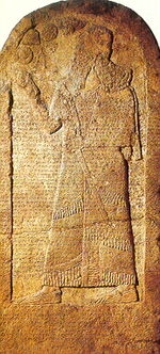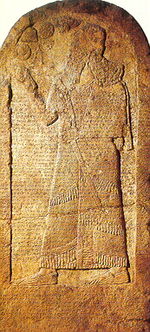
Kurkh Monolith
Encyclopedia

Assyria
Assyria was a Semitic Akkadian kingdom, extant as a nation state from the mid–23rd century BC to 608 BC centred on the Upper Tigris river, in northern Mesopotamia , that came to rule regional empires a number of times through history. It was named for its original capital, the ancient city of Assur...
n document that contains a description of the Battle of Qarqar
Battle of Qarqar
The Battle of Qarqar was fought in 853 BC when the army of Assyria led by king Shalmaneser III encountered an allied army of 12 kings at Qarqar led by Hadadezer of Damascus and King Ahab of Israel...
at the end. Today it stands in the British Museum
British Museum
The British Museum is a museum of human history and culture in London. Its collections, which number more than seven million objects, are amongst the largest and most comprehensive in the world and originate from all continents, illustrating and documenting the story of human culture from its...
but it was originally found at the Kurdish
Kurdish people
The Kurdish people, or Kurds , are an Iranian people native to the Middle East, mostly inhabiting a region known as Kurdistan, which includes adjacent parts of Iran, Iraq, Syria, and Turkey...
village of Kurkh (Turkish Üçtepe
Üçtepe
Üçtepe is a place name in Turkish and it may refer to,*Üçtepe, a village in İmamoğlu district of Adana Province, Turkey*Üçtepe is a village in Erdemli ditrict of Mersin Province, Turkey...
), near the town of Bismil
Bismil
Bismil is a district of Diyarbakır Province of Turkey. The population is 56,887 . The mayor is Cemile Eminoğlu .-Brief History:...
in the province of Diyarbakır
Diyarbakır
Diyarbakır is one of the largest cities in southeastern Turkey...
, Turkey
Turkey
Turkey , known officially as the Republic of Turkey , is a Eurasian country located in Western Asia and in East Thrace in Southeastern Europe...
. The Monolith stands some 2.2 metres tall, and roughly covers years one through six of the reign of Assyrian king Shalmaneser III
Shalmaneser III
Shalmaneser III was king of Assyria , and son of the previous ruler, Ashurnasirpal II....
(859-824 BC), although the fifth year is missing. Some scholars believe that the scribe who wrote the Monolith was sloppy, and have pointed out a number of possible errors in the text, like the identification of Byblos
Byblos
Byblos is the Greek name of the Phoenician city Gebal . It is a Mediterranean city in the Mount Lebanon Governorate of present-day Lebanon under the current Arabic name of Jubayl and was also referred to as Gibelet during the Crusades...
as Que
Quwê
Quwê – also spelled Que, Kue, Qeve, Coa, Kuê and Keveh – was a "Neo-Hittite" Assyrian vassal state or province at various times from the 9th century BCE to shortly after the death of Ashurbanipal around 627 BCE in the lowlands of eastern Cilicia, and the name of its capital city,...
.
The Monolith mainly deals with campaigns Shalmaneser made in western Mesopotamia
Mesopotamia
Mesopotamia is a toponym for the area of the Tigris–Euphrates river system, largely corresponding to modern-day Iraq, northeastern Syria, southeastern Turkey and southwestern Iran.Widely considered to be the cradle of civilization, Bronze Age Mesopotamia included Sumer and the...
and Syria
Syria
Syria , officially the Syrian Arab Republic , is a country in Western Asia, bordering Lebanon and the Mediterranean Sea to the West, Turkey to the north, Iraq to the east, Jordan to the south, and Israel to the southwest....
, fighting extensively with the countries of Bit Adini
Beth Eden
Bit Adini, A city or region of Syria, called sometimes Bit Adini in Assyrian sources, was an Aramaean state that existed as an independent kingdom during the 10th and 9th Centuries BC, with its capital at Til Barsib . In 856 BC, the kingdom was conquered and absorbed into the Assyrian Empire during...
and Carchemish
Carchemish
Carchemish or Kargamış was an important ancient city of the Mitanni, Hittite and Neo Assyrian Empires, now on the frontier between Turkey and Syria. It was the location of an important battle between the Babylonians and Egyptians, mentioned in the Bible...
. At the end of the Monolith comes the account of the Battle of Qarqar
Battle of Qarqar
The Battle of Qarqar was fought in 853 BC when the army of Assyria led by king Shalmaneser III encountered an allied army of 12 kings at Qarqar led by Hadadezer of Damascus and King Ahab of Israel...
, where an alliance of twelve kings fought against Shalmaneser at the Syrian city of Qarqar. This alliance, comprising eleven kings, was led by Irhuleni of Hamath and Hadadezer
Hadadezer
Hadadezer ; also known as Adad-Idri and possibly the same as Bar-Hadad II ; Ben-Hadad II , was the king of Aram Damascus at the time of the battle of Qarqar against the Assyrian king Shalmaneser III in 853 BCE. He and Irhuleni of Hamath led a coalition of eleven kings at Qarqar...
of Damascus
Damascus
Damascus , commonly known in Syria as Al Sham , and as the City of Jasmine , is the capital and the second largest city of Syria after Aleppo, both are part of the country's 14 governorates. In addition to being one of the oldest continuously inhabited cities in the world, Damascus is a major...
, describing also a large force led by King Ahab
Ahab
Ahab or Ach'av or Achab in Douay-Rheims was king of Israel and the son and successor of Omri according to the Hebrew Bible. His wife was Jezebel....
of Israel. The Monolith is also the first time that the Arabs make an appearance in world history, fielding a contingent containing dromedaries
Dromedary
The dromedary or Arabian camel is a large, even-toed ungulate with one hump on its back. Its native range is unclear, but it was probably the Arabian Peninsula. The domesticated form occurs widely in North Africa and the Middle East...
led by King Gindibu
Gindibu
Gindibu led the Arab forces at the Battle of Qarqar , as an ally of Ben Haddad the king of the Aramean state of Damascus, as they fought against Assyria...
.
Scribal errors and disputes
There are a number of issues surrounding the written words contained in the Monolith, mostly surrounding the text of the Battle of Qarqar. For example, the scribe lists one city as Gu-a-a, which some scholars believe refers to QueQuwê
Quwê – also spelled Que, Kue, Qeve, Coa, Kuê and Keveh – was a "Neo-Hittite" Assyrian vassal state or province at various times from the 9th century BCE to shortly after the death of Ashurbanipal around 627 BCE in the lowlands of eastern Cilicia, and the name of its capital city,...
. However, H. Tadmor believes that this is actually a mistake, with Gu-a-a being an incorrect spelling for Gu-bal-a-a, that is, Byblos. Other scholars have also pointed out that it would be more logical if Shalmaneser fought Byblos instead of Que, because it would make better geographic sense - since the other kings of the area are polities to the south and west of Assyria, it might be expected that another city-state in that area - Byblos - would fight at Qarqar, rather than Que, which is in Cilicia
Cilicia
In antiquity, Cilicia was the south coastal region of Asia Minor, south of the central Anatolian plateau. It existed as a political entity from Hittite times into the Byzantine empire...
.
Another issue with regard to spelling is the term musri, which is Akkadian
Akkadian language
Akkadian is an extinct Semitic language that was spoken in ancient Mesopotamia. The earliest attested Semitic language, it used the cuneiform writing system derived ultimately from ancient Sumerian, an unrelated language isolate...
for "march". Tadmor says that the actual Musri people had been conquered by the Assyrians in the 11th century BC, and thus believes that this reference to Musri must be "Egypt", although some scholars dispute this.
Another major error in the text is the assertion that Assyria fought "twelve kings". Casual readers will note that the Monolith in fact lists eleven, but some scholars have attempted to explain that there really is a missing king, stemming from the description of "Ba'sa the man of Bit-Ruhubi, the Ammonite". One scholar suggests that the two entities be split into "Bit-Ruhubi" Beth-Rehob, a state in southern Syria
Syria
Syria , officially the Syrian Arab Republic , is a country in Western Asia, bordering Lebanon and the Mediterranean Sea to the West, Turkey to the north, Iraq to the east, Jordan to the south, and Israel to the southwest....
and "Ammon
Ammon
Ammon , also referred to as the Ammonites and children of Ammon, was an ancient nation located east of the Jordan River, Gilead, and the Dead Sea, in present-day Jordan. The chief city of the country was Rabbah or Rabbath Ammon, site of the modern city of Amman, Jordan's capital...
", a state in the Trans-Jordan. However, "twelve kings" is a common Mesopotamian literary device for any kind of alliance, so it is entirely possible that the scribe here was using a figure of speech, rather than miscounting.
See also
- BibleBibleThe Bible refers to any one of the collections of the primary religious texts of Judaism and Christianity. There is no common version of the Bible, as the individual books , their contents and their order vary among denominations...
- Books of KingsBooks of KingsThe Book of Kings presents a narrative history of ancient Israel and Judah from the death of David to the release of his successor Jehoiachin from imprisonment in Babylon, a period of some 400 years...
- List of artifacts significant to the Bible
- Old TestamentOld TestamentThe Old Testament, of which Christians hold different views, is a Christian term for the religious writings of ancient Israel held sacred and inspired by Christians which overlaps with the 24-book canon of the Masoretic Text of Judaism...

